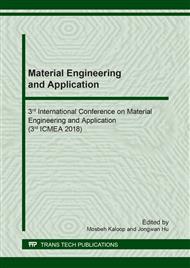[1]
A. Micka, A. Siepelmeyer, A. Holz, et al, Effect of consumption of chicory inulin on bowel function in healthy subjects with constipation: a randomized, double-blind, placebo-controlled trial, Int. J. Food Sci. & Nutr. 68 (2016) 82-89.
DOI: 10.1080/09637486.2016.1212819
Google Scholar
[2]
E. J. Vandamme, D. G. Derycke, Microbial inulinases: fermentation process, properties, and applications, Adv. Appl. Microbiol. 29 (1983) 139-176.
DOI: 10.1016/s0065-2164(08)70356-3
Google Scholar
[3]
H. Alexiou, A. Franck, Prebiotic inulin-type fructans: nutritional benefits beyond dietary fibre source, Nutr. Bull. 33 (2008) 227-233.
DOI: 10.1111/j.1467-3010.2008.00710.x
Google Scholar
[4]
G. Schaafsma, J. L. Slavin, Significance of Inulin Fructans in the Human Diet, Compr. Rev. Food Sci. Food Saf. 14 (2015) 37-47.
DOI: 10.1111/1541-4337.12119
Google Scholar
[5]
A. H. Konsowa, M. E. Ossman, Y. S. Chen et al., Decolorization of industrial wastewater by ozonation followed by adsorption on activated carbon, J. Hazard. Mater. 176 (2010) 181-185.
DOI: 10.1016/j.jhazmat.2009.11.010
Google Scholar
[6]
P. Baldrian, V Merhautová, J Gabriel et al., Decolorization of synthetic dyes by hydrogen peroxide with heterogeneous catalysis by mixed iron oxides, Appl. Catal. B. Environ. 66 (2006) 258-264.
DOI: 10.1016/j.apcatb.2006.04.001
Google Scholar
[7]
F. J. Cervantes, A. Garcia-Espinosa, M. A. Moreno-Reynosa et al., Immobilized redox mediators on anion exchange resins and their role on the reductive decolorization of azo dyes, Environ. Sci. Technol. 44 (2010) 1747.
DOI: 10.1021/es9027919
Google Scholar
[8]
J. Liu, J. Luo, Y. Sun et al., A simple method for the simultaneous decoloration and deproteinization of crude levan extract from Paenibacillus polymyxa EJS-3 by macroporous resin, Bioresour. Technol. 101 (2010) 6077.
DOI: 10.1016/j.biortech.2010.03.019
Google Scholar
[9]
R. Yang, D. Meng, Y. Song et al, Simultaneous decoloration and deproteinization of crude polysaccharide from pumpkin residues by cross-linked polystyrene macroporous resin, J. Agric. Food Chem. 60 (2012) 8450-8456.
DOI: 10.1021/jf3031315
Google Scholar
[10]
A. Zwir-Ferenc, M. Biziuk, Solid phase extraction technique - Trends, opportunities and applications, Pol. J. Environ. Stud. 15 (2006) 677-690.
Google Scholar
[11]
C. W. Huck, G. K. Bonn. Recent developments in polymer-based sorbents for solid-phase extraction, J. Chromatogr. A. 885 (2000) 51-72.
DOI: 10.1016/s0021-9673(00)00333-2
Google Scholar
[12]
Y. Shi, T. Liu, Y. Han et al., An efficient method for decoloration of polysaccharides from the sprouts of Toona sinensis (A. Juss.) Roem by anion exchange macroporous resins, Food Chem. 217 (2017) 461-468.
DOI: 10.1016/j.foodchem.2016.08.079
Google Scholar
[13]
J. Liu, J. Luo, Y. Sun et al., A simple method for the simultaneous decoloration and deproteinization of crude levan extract from Paenibacillus polymyxa EJS-3 by macroporous resin, Bioresour. Technol. 101 (2010) 60-77.
DOI: 10.1016/j.biortech.2010.03.019
Google Scholar
[14]
R. Yang, D. Meng, Y. Song et al., Simultaneous decoloration and deproteinization of crude polysaccharide from pumpkin residues by cross-linked polystyrene macroporous resin, J. Agric. Food Chem. 60 (2012) 8450-8456.
DOI: 10.1021/jf3031315
Google Scholar
[15]
Z. Zhao, L. Dong, Y. Wu et al., Preliminary separation and purification of rutin and quercetin from Euonymus alatus (Thunb.) Siebold extracts by macroporous resins, Food & Bioprod. Process. 89 (2011) 266-272.
DOI: 10.1016/j.fbp.2010.11.001
Google Scholar
[16]
Y. Liu, D. Di, Q. Bai et al., Preparative separation and purification of rebaudioside a from steviol glycosides using mixed-mode macroporous adsorption resins, J. Agric. Food Chem. 59 (2011) 9629-9636.
DOI: 10.1021/jf2020232
Google Scholar
[17]
Y. Fu, Y. Zu, W. Liu et al., Preparative separation of vitexin and isovitexin from pigeonpea extracts with macroporous resins, J. Chromatogr. A. 1139 (2007) 206-213.
DOI: 10.1016/j.chroma.2006.11.015
Google Scholar
[18]
C. W. Huck, Recent developments in polymer-based sorbents for solid-phase extraction, J. Chromatogr. A. 885 (2000) 51-72.
DOI: 10.1016/s0021-9673(00)00333-2
Google Scholar
[19]
Y. F. Jiao, J. Su, Z. J. Wang et al., Adsorbed Performance of Oxalic Acid with 201×7 Strong-Alkaline Anion Resin, J. Chinese Soc. Rare Earths. 33 (2015) 581-587.
Google Scholar
[20]
M. Dubois, K. A. Gilles, J. K. Hamilton et al., Colorimetric method for determination of sugars and related substances, Anal. Chem. 28 (1956) 350-356.
DOI: 10.1021/ac60111a017
Google Scholar


